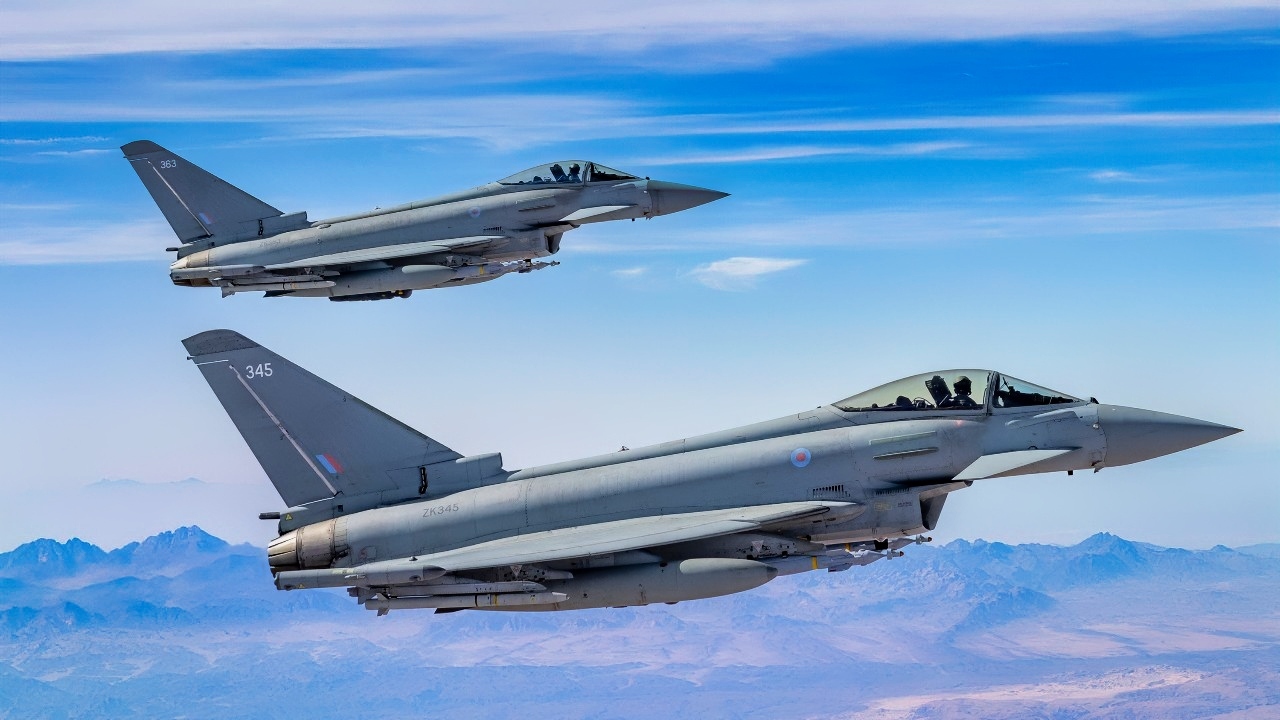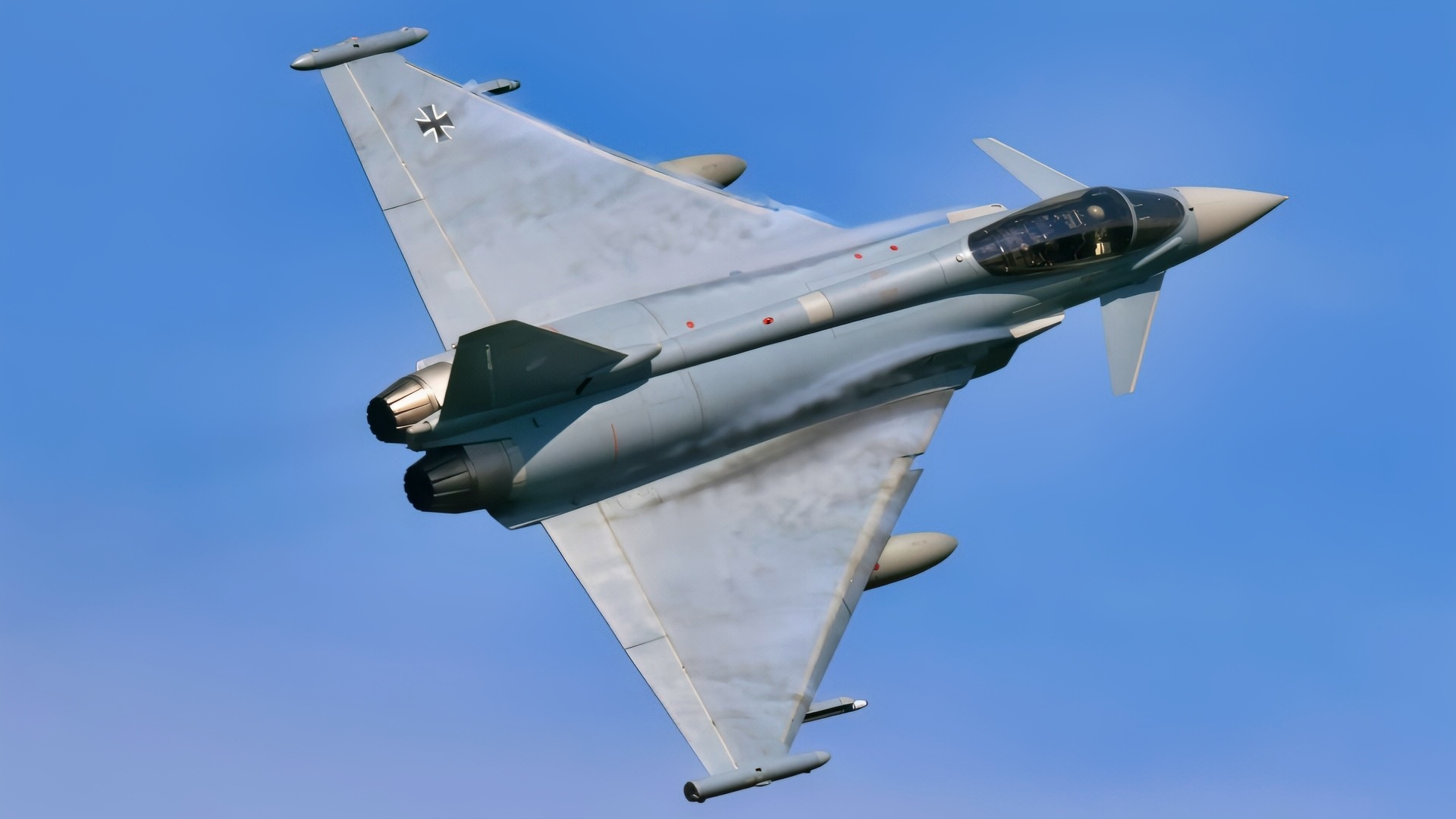Key Points and Summary – The F-35 remains the world’s most popular fighter, but politics and price pressure are opening lanes for the Eurofighter Typhoon.
-Several European capitals are reassessing Lightning II purchases amid tariff worries, supply-chain risk, and dependence on U.S. support.

Image of two RAF Typhoon FGR Mk 4 aircraft, seen here during a routine mission over the Middle East as part of Operation Shader.
Op SHADER air to air refuelling sortie took place on Wednesday 13th November, maintaining Typhoon presence across the Middle East running routine missions.
Typhoon, Voyager and Atlas A400 aircraft operate from RAF AKrotiri as part of Op SHADER, part of the International coalition effort fighting terrorist organisations in the Middle East region.
The RAF has been engaged in this mission since 2014 combating Daesh in Iraq and Eastern Syria as well as Houthi Rebels more recently in Yemen who threaten global shipping. Image Credit: Creative Commons.
-Eurofighter’s pitch: a nimble, non-stealth “4+ gen” jet with EJ200 power, E-Scan radar, PIRATE IRST, and a deep weapons bench—plus lower flying-hour costs and growing production targets.
-Still, the F-35’s stealth, sensor fusion, and unit price keep it ahead on pure capability.
-Expect hard lobbying: if Washington’s diplomacy wobbles, Typhoon could capture near-term orders while F-35 defends its long-term edge.
Out With the F-35, In With the Eurofighter Typhoon
The F-35 Lightning II is a really popular fighter jet overseas these days.
And the why matters. 19 international partners operate the American jet, manufactured by Lockheed Martin in Fort Worth, Texas.
The U.S. military has engaged in high levels of what I call “fighter plane diplomacy” with the F-35. Large amounts of goodwill can be chalked up to F-35 exports.
This provides a much-needed boost to soft and hard power for the United States and its allies.
But all is not well in F-35 fighter land…
Trump Has Lost That Loving Feeling
But fighter plane diplomacy with the F-35 has suffered under President Donald Trump.
Some countries are reconsidering or even canceling F-35 orders.

Eurofighter Typhoon. Image Credit: Creative Commons.
Canada is trying to figure out if it will purchase the entire batch of 88 F-35s that it agreed to in prior years.
European Countries That Are Suspicious of the F-35
Spain will not buy the F-35. Switzerland had earlier decided to purchase the Lightning II, but it is being affected by Trump tariffs, and its order may become more expensive.
Denmark bought an F-35 shipment, but it may have regretted the decision because the Danes might be relying on the Americans too much for their defense needs. Portugal may also pass on the Lightning II.
The Eurofighter Typhoon Can Step Into the Breach
European fighter jet manufacturers are salivating. Airplanes like the Eurofighter Typhoon and its upgraded variants are looking better to those who have passed on the F-35 or who are re-considering.
The Typhoon is built by a four-country European consortium, and more are being produced as new customers come online.
“We are eyeing already a [production] rate of 30 aircraft, once [new] export orders start kicking in,” Eurofighter CEO Jorge Tamarit Degenhardt told reporters at the Paris Air Show in June.
However, the consortium has a long way to go to meet that goal. Only 14 of the Typhoons are built each year. In the next three years, the numbers will increase to 20 airplanes annually, before the Europeans can hit that 30-aircraft production quota. Still, this should be seen as a success for the Eurofighter.
Stoke Those Typhoon Production Lines
“We need to do it [ramp up production] fast,” said Degenhardt. “Since these deliveries are happening within the next decade or decades, we need to sustain this increase of industrial throughput, [by developing] the best new manufacturing technologies, and we need to strengthen as well, our supply chain of 400 critical suppliers.”
The countries involved with the Typhoon are Germany, Italy, Spain, and the United Kingdom. All of these partners could use the boost in job growth and economic development from being suppliers for the Typhoon. The consortium has plans to sell the Eurofighter to Austria, Poland, Turkey, and Saudi Arabia. This will keep the production lines going for several years into the future.
The consortium’s sales and marketing teams are certainly going to attempt to build on this demand by targeting the militaries from Spain, Portugal, and Canada who may not eventually pull the trigger on F-35 purchases.
More About the Eurofighter Typhoon
The Typhoon is not fully stealthy, but it does have radar-evading characteristics. It could be compared to the American F-15EX. Both are fourth-generation “+” or “++” fighters. The Eurofighter consortium believes that the Typhoon’s percentage of space-aged metals (15 percent of the entire airplane) can make it stealthier. This creates an airplane that is 30 percent lighter than the competition.
The Eurofighter Typhoon also features the advanced EJ200 engines, each with 90kN of thrust. When you combine that powerplant with the lighter airframe, the upgraded Typhoon can be faster and more maneuverable – reaching a top speed of MACH 2.0 with a maximum altitude of 55,000 feet.
The Eurofighter consortium believes that the upgraded Typhoon has the best situational awareness in its class. The E-Scan radar has a 50 percent wider array than the older model with fixed plate systems. The Pirate System (Passive Infra-Red Airborne Tracking Equipment) is great for detecting and tracking enemy airplanes.
The cockpit is pilot-friendly, featuring advanced head-up and head-down displays, which enable the aviator to use night-vision goggles. This is more accurate and has lower latency in night-flying situations.
The weapons load-out is impressive, featuring the METEOR air-to-air missile, the IRIS-T air-to-air missile, and the ASRAAM and AMRAAM air-to-air missiles.
For surface strike, there is the Stormshadow air-to-ground missile, the Brimstone II, and many other missiles for targets on the ground.
The cost comparison between the F-35 and the Typhoon is similar. Unit costs for each are $80 to $90 million for the Lightning II compared to $100 to $124 million for the Eurofighter. But the Typhoon is cheaper to keep in the air at $18,000 per flight hour.
While the Eurofighter Typhoon brings much to the table, the F-35 is superior. The Lightning II is slower, but it is more maneuverable. Plus, it is fully stealthy. I like the Typhoon’s weapons load-out, and the high number of different munitions may give it the nod over the F-35. The Lightning II also costs less per airplane.
The United States military must step up its game if it wants to sell F-35s to the Canadians and Europeans who are balking on the Lightning II. It is not clear what Lockheed Martin should do. The manufacturer often declines to comment on relationships with other countries. It usually sends reporters to the U.S. Department of Defense when asked about losing sales to partners that would usually love the F-35.
This may take some persuasion from Donald Trump himself if U.S. fighter plane diplomacy is successful. The president needs to make the case for the F-35 as being the most popular airplane for many countries, and he must communicate to air forces sitting on the fence that he will not extend tariffs or disparage NATO.
The Eurofighter Typhoon is likely to jump into the gap and create opportunities for the consortium to have orders for the next ten years. This is good news to the group as it predicts cash flow and profit in the coming years. Sales of the F-35 could suffer in the meantime, even though it is a superior fighter jet.
About the Author: Brent M. Eastwood
Brent M. Eastwood, PhD is the author of Don’t Turn Your Back On the World: a Conservative Foreign Policy and Humans, Machines, and Data: Future Trends in Warfare plus two other books. Brent was the founder and CEO of a tech firm that predicted world events using artificial intelligence. He served as a legislative fellow for US Senator Tim Scott and advised the senator on defense and foreign policy issues. He has taught at American University, George Washington University, and George Mason University. Brent is a former US Army Infantry officer. He can be followed on X @BMEastwood.
More Military
Seawolf-Class: The Best Submarine Ever?
The Royal Navy Has a Destroyer Stuck in Port for 3,000 Days
America Is the King of Stealth Fighters
China’s J-20 Mighty Dragon Stealth Fighter Has Just 1 Mission










